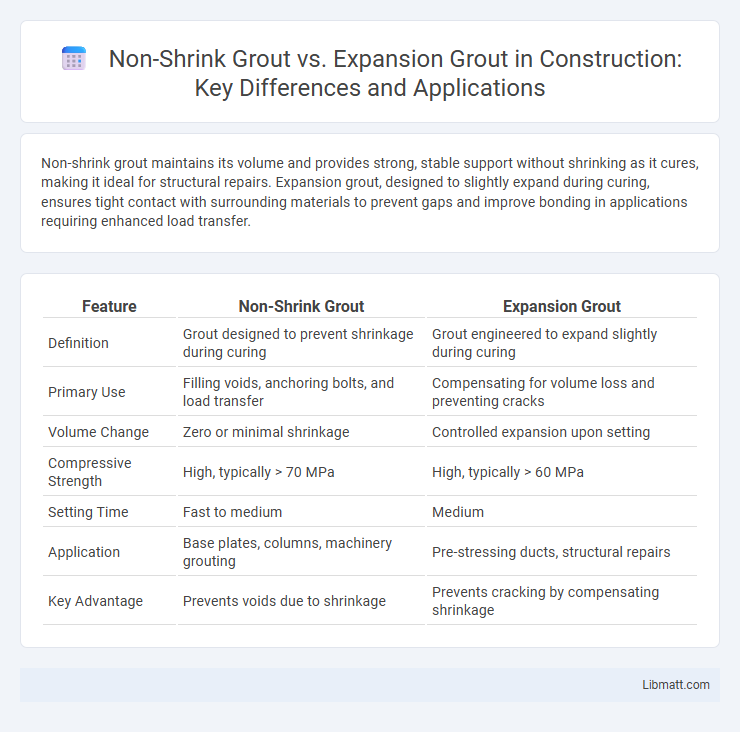Non-shrink grout maintains its volume and provides strong, stable support without shrinking as it cures, making it ideal for structural repairs. Expansion grout, designed to slightly expand during curing, ensures tight contact with surrounding materials to prevent gaps and improve bonding in applications requiring enhanced load transfer.
Table of Comparison
| Feature | Non-Shrink Grout | Expansion Grout |
|---|---|---|
| Definition | Grout designed to prevent shrinkage during curing | Grout engineered to expand slightly during curing |
| Primary Use | Filling voids, anchoring bolts, and load transfer | Compensating for volume loss and preventing cracks |
| Volume Change | Zero or minimal shrinkage | Controlled expansion upon setting |
| Compressive Strength | High, typically > 70 MPa | High, typically > 60 MPa |
| Setting Time | Fast to medium | Medium |
| Application | Base plates, columns, machinery grouting | Pre-stressing ducts, structural repairs |
| Key Advantage | Prevents voids due to shrinkage | Prevents cracking by compensating shrinkage |
Introduction to Grout Types: Non-shrink vs Expansion
Non-shrink grout is engineered to maintain its volume and prevent shrinking during the curing process, ensuring stable and durable structural support in construction applications. Expansion grout is designed to actively expand slightly as it sets, filling gaps and enhancing load transfer by compensating for slight voids or irregularities. Both types are critical for different scenarios: non-shrink grout stabilizes heavy machinery bases, while expansion grout is preferred in situations requiring precise gap filling and stress distribution.
Understanding Non-shrink Grout
Non-shrink grout is specially formulated to maintain its original volume during curing, preventing voids and ensuring a solid, stable bond between surfaces. Unlike expansion grout, which slightly expands to fill gaps, non-shrink grout avoids dimensional changes that could disrupt structural alignment. Your choice of non-shrink grout guarantees consistent strength and durability for applications requiring precise load transfer and minimal movement.
What is Expansion Grout?
Expansion grout is a specialized type of grout designed to increase slightly in volume after application, effectively filling cracks and compensating for shrinkage that typically occurs during curing. Unlike non-shrink grout, which maintains its original volume to prevent gaps, expansion grout actively expands to ensure a tight, secure bond in applications like heavy machinery bases and structural repairs. Your choice of expansion grout can enhance durability and stability in environments subject to dynamic loads or temperature fluctuations.
Key Differences Between Non-shrink and Expansion Grouts
Non-shrink grout maintains its volume and strength during curing, ensuring minimal shrinkage and solid load transfer in structural applications. Expansion grout, on the other hand, is designed to expand slightly as it sets, filling gaps and preventing voids or settlement beneath machinery or baseplates. Your choice depends on whether you require constant volume for stability or slight expansion for gap filling and enhanced surface contact.
Material Composition and Chemical Properties
Non-shrink grout typically consists of cement, fine aggregates, shrinkage-compensating additives, and water-reducing agents, ensuring minimal volume change after setting to maintain structural integrity. Expansion grout contains expansive agents like calcium sulfoaluminate, which induce controlled swelling during hydration to fill voids and prevent gaps. Understanding these chemical properties helps you select the right grout for applications requiring precise dimensional stability or void-filling performance.
Common Applications of Non-shrink Grout
Non-shrink grout is commonly used in construction projects requiring precise leveling and load transfer, such as under machine bases, bridge bearings, and structural columns. It ensures minimal volume change during curing, maintaining stability and alignment in critical infrastructure. Expansion grout, by contrast, is typically employed where compensating for shrinkage and improving bond strength in concrete repairs is essential.
Typical Uses of Expansion Grout
Expansion grout is typically used in applications where concrete or structures are subject to heavy loads and require compensation for potential shrinkage or movement, such as in machinery bases, bridge bearings, and precast panels. This type of grout ensures a tight, durable bond that maintains stability under stress by expanding slightly after setting to fill gaps and prevent voids. Your choice of expansion grout is crucial when securing heavy equipment or structural components to maintain alignment and prevent cracking.
Performance Factors: Strength, Durability, and Setting Time
Non-shrink grout offers high compressive strength and excellent durability by minimizing volume changes during curing, ensuring stability in structural applications. Expansion grout enhances bonding by expanding slightly as it sets, which improves contact between surfaces but may have a variable setting time depending on formulation. Your choice depends on project requirements for strength, durability, and setting time, with non-shrink grout being ideal for load-bearing joints and expansion grout suitable for filling gaps with active expansion needs.
Choosing the Right Grout for Your Project
Non-shrink grout maintains its volume during curing, making it ideal for structural repairs and anchoring where dimensional stability is critical. Expansion grout is formulated to slightly expand as it sets, helping to fill voids and improve bonding in applications like machinery foundations. Choosing the right grout for your project involves assessing load requirements, environmental conditions, and the need for volume stability or controlled expansion.
Conclusion: Non-shrink Grout vs Expansion Grout – Which to Use?
Non-shrink grout is ideal for applications requiring high compressive strength and minimal volume change, ensuring structural stability under load-bearing conditions. Expansion grout is best suited for filling cracks and joints where controlled expansion helps maintain tight contact and prevents voids. Choose non-shrink grout for heavy load infrastructure and expansion grout for sealing and repairing concrete surfaces where expansion is beneficial.
Non-shrink grout vs Expansion grout Infographic

 libmatt.com
libmatt.com